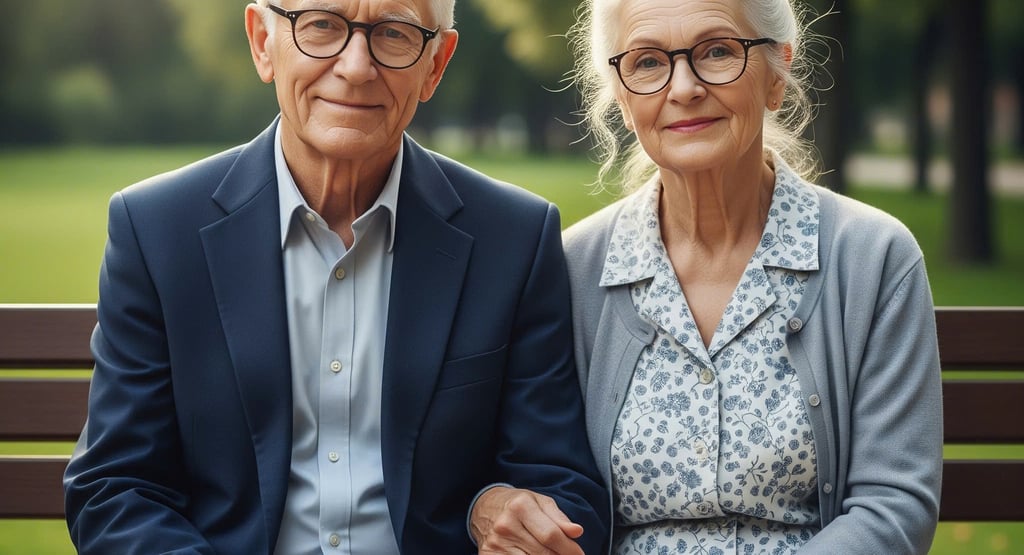Elderly people with myopia – do they need to wear glasses? - Myopia and retinal diseases in the elderly.
2/18/20257 min read


Introduction to Myopia and Aging
Myopia, commonly known as nearsightedness, is a refractive error that affects one's ability to see distant objects clearly while maintaining clarity for those nearer. As individuals age, the prevalence of myopia can become increasingly significant, particularly among the elderly population. Aging brings about various natural changes within the eye, including alterations in the lens's flexibility and the overall anatomy of the eye, which can exacerbate or even initiate myopic conditions.
Statistical studies indicate that a notable proportion of seniors experience myopia, with factors such as genetics and lifestyle contributing to its development. The implication of this condition is substantial; many elderly individuals may find themselves relying on corrective aids such as glasses for optimal vision. However, the question remains: do they truly need glasses? Understanding the unique vision challenges faced by older adults is crucial, as these can vary widely based on personal health, comorbid conditions, and lifestyle factors.
One of the critical changes in the visual system due to aging is the loss of elasticity in the lens, leading to presbyopia. This condition often coexists with myopia, demanding a nuanced approach when prescribing vision correction. Additionally, age-related diseases like cataracts and glaucoma can further complicate the situation, potentially altering the way myopia is managed in seniors. Thus, it become evident that understanding the intricate relationship between aging and vision is essential for effectively addressing the visual needs of elderly individuals. This section serves as a foundation for exploring whether glasses are an absolute necessity for seniors facing the challenges posed by myopia.
The Eye and Aging: What to Expect
As individuals age, their eyes undergo a variety of physiological changes that can significantly impact vision. One of the most noticeable changes is the decline in lens elasticity, which affects the eye's ability to focus on objects at varying distances. This condition, known as presbyopia, typically begins to manifest in the early 40s, complicating the visual landscape for those who may already be dealing with myopia, or nearsightedness. The reduced flexibility of the lens makes it increasingly difficult to see close objects clearly, leading many elderly individuals to require reading glasses in addition to their distance correction.
Furthermore, the clarity of the lens diminishes with age, as the lens becomes more opacified, a condition that may lead to the development of cataracts. Cataracts are particularly prevalent in the elderly demographic and can exacerbate the effects of existing myopia by clouding vision and altering color perception. It is important to note that while myopia primarily affects distance vision, these concurrent conditions may blur overall vision, creating further challenges for older adults already navigating the complexities of aging.
Another prevalent condition affecting older adults is glaucoma, a group of eye diseases that can lead to optic nerve damage and vision loss. While myopia is known to increase the risk of developing glaucoma, the age-related increase in intraocular pressure also contributes to this risk. Regular eye examinations are crucial for this demographic, as early detection and management of eye diseases significantly improve visual outcomes and quality of life.
In summary, the aging process brings about a spectrum of eye changes that can impact vision quality. Understanding these transformations is essential for older adults and their caregivers to make informed decisions regarding eye health, including the potential need for corrective eyewear.
Myopia and Its Impact on Quality of Life
Myopia, commonly known as nearsightedness, poses significant challenges for elderly individuals, influencing their overall quality of life. As people age, their vision often diminishes further, exacerbating the difficulties associated with myopia. Tasks that require clear distance vision, such as driving, watching television, or enjoying outdoor activities, can become increasingly problematic for the elderly population. The dependence on corrective eyewear like glasses becomes crucial to navigate these everyday tasks effectively.
Moreover, many older adults face challenges with reading fine print, which can limit their ability to enjoy literature, keep up with current events, or engage in hobbies that require close vision. This limitation not only hampers their engagement with the world around them but can also reduce social interactions, leading to feelings of isolation. The need for bifocals or progressive lenses adds additional complexities to their visual experience, often resulting in a tedious adjustment period.
Beyond the physical implications, the emotional and psychological effects of impaired vision in the elderly cannot be overlooked. Clear vision is intrinsically linked to independence; when vision deteriorates, many elderly individuals may feel a loss of autonomy, leading to anxiety or depression. The fear of falling or becoming dependent on others for assistance can further intensify these emotional concerns. Therefore, understanding and addressing the implications of myopia in the elderly is crucial not only for promoting their social and recreational engagement but also for enhancing their emotional well-being.
To mitigate these challenges, older adults should regularly consult with optometrists to evaluate their vision needs and explore suitable corrective options. By prioritizing comprehensive vision care, they can maintain their quality of life and enjoy greater independence well into their later years.
Retinal Diseases Associated with Myopia
Myopia, commonly known as nearsightedness, can lead to a range of retinal diseases, particularly in elderly individuals. Among the most significant conditions linked to high levels of myopia are myopic maculopathy and retinal detachment. Myopic maculopathy arises when the excessive elongation of the eyeball, a consequence of myopia, leads to structural changes in the retina, particularly the macula, which is responsible for central vision. This condition can manifest through symptoms such as blurred vision, distortion, and even central blind spots, severely impacting daily life for the affected individuals.
Moreover, retinal detachment, a more acute condition, is characterized by the separation of the retina from its underlying tissue. This situation can be precipitated by myopic changes, as the retina tends to become thinner and more fragile in highly myopic individuals. Symptoms of retinal detachment include sudden flashes of light, an increase in floaters, and a shadow or curtain appearing across the visual field. Prompt recognition of these symptoms is crucial, as early intervention can often restore some degree of vision and prevent permanent loss.
Do Elderly People Need Glasses for Myopia?
Myopia, also known as nearsightedness, affects a substantial portion of the elderly population. As individuals age, the progression and management of myopia can present unique challenges, prompting the inquiry of whether glasses are necessary for elderly individuals grappling with this condition. Various factors influence the decision to wear corrective eyewear, including the severity of myopia, the existence of other ocular diseases, and the individual's daily activities.
For some elderly patients, wearing glasses may be essential to ensure adequate vision. Those with mild to moderate myopia often benefit from prescription lenses, as these can significantly enhance the clarity of vision for tasks such as reading, watching television, or socializing. In contrast, individuals with severe myopia may face additional complications, such as an increased risk for retinal issues or cataracts, which can necessitate more regular eye exams and careful monitoring. Eye care professionals generally recommend that elderly individuals with documented myopia adhere to prescribed corrective measures, as this can improve their quality of life.
However, it is also crucial to evaluate the lifestyle of the individual. Some elderly persons may feel comfortable without glasses for specific activities or might manage well with multifocal lenses that accommodate both near and distance vision. Furthermore, factors such as mobility, cognitive function, and personal preferences can play significant roles in determining the necessity of glasses. For instance, those who engage in frequent outdoor activities may find that prescription lenses enhance their safety and experience.
Ultimately, the necessity of glasses for myopia in elderly individuals should be determined collaboratively with eye healthcare providers, ensuring personalized recommendations suitable to each individual's unique circumstances and visual needs.
Alternatives to Glasses for Managing Myopia
As myopia, or nearsightedness, progresses in the elderly population, individuals often explore alternatives to traditional glasses for managing their vision. While prescription eyewear remains common, various options exist that cater to specific needs and preferences, particularly for older adults.
One viable alternative is the use of contact lenses. Contact lenses can offer a wider field of vision compared to glasses, which can be particularly advantageous for elderly individuals who may have difficulty with peripheral vision. There are various types of contact lenses suitable for myopia, including daily disposables, extended wear, and specially designed multifocal lenses. However, it is essential to consider that older adults may face challenges in handling and maintaining contact lenses, such as decreased dexterity or ocular health issues, which may make regular lens use less feasible.
Surgical options are another alternative for managing myopia, such as laser refractive surgery, including LASIK and PRK. These procedures correct the eye's shape to improve focusing ability, potentially reducing or eliminating the need for glasses altogether. While surgery typically yields long-lasting results, potential candidacy may be limited for elderly individuals due to factors such as the presence of cataracts or other age-related eye conditions. Additionally, the risks associated with surgery may warrant thorough evaluation and consultation with an ophthalmologist.
Low-vision aids represent another option for elderly individuals facing myopia. These devices, ranging from magnifying glasses to specialized lighting systems, assist in maximizing existing vision rather than correcting it outright. For those with significant vision impairment, low-vision aids can empower users to participate in daily activities, enhancing their overall quality of life.
In summary, while glasses are a staple for many managing myopia, alternatives such as contact lenses, surgical intervention, and low-vision aids may prove beneficial for older adults, each presenting unique advantages and challenges that require careful consideration.
Conclusion: The Importance of Vision Care in the Elderly
In conclusion, understanding myopia in the elderly is crucial for promoting effective vision care practices. As individuals age, they may experience various changes in their eyesight, including worsening myopia. This condition, characterized by difficulty focusing on distant objects, can significantly impact the quality of life for older adults. Regular vision assessments are essential to identify and address myopia and related eye conditions early, ensuring that appropriate corrective measures, such as glasses, are provided when necessary.
Individualized approaches to managing myopia in older adults are vital, given the diverse needs and experiences within this population. Each person's vision requirements can significantly differ, necessitating tailored solutions to address their specific challenges. Regular consultations with eye care professionals can help establish these personalized plans, incorporating the latest advancements in eye care and technology to enhance vision health.
Ultimately, by recognizing the importance of vision care and fostering a supportive environment, we can help older adults navigate the challenges associated with myopia and enhance their overall well-being and independence. Promoting awareness about the significance of eye health in aging populations is vital for ensuring that the elderly receive the care they need to thrive.
